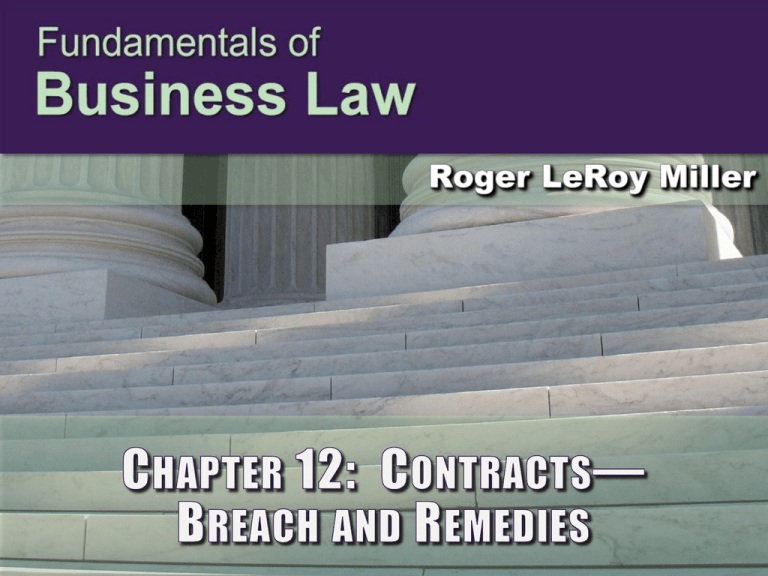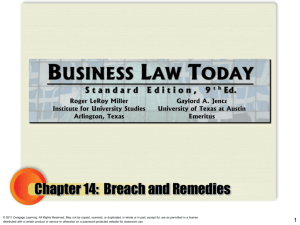
Chapter 1: Legal Ethics
1
Learning Objectives
1. What is the difference between
compensatory and consequential
damages? What are nominal damages
and when do courts award them?
2. What is the standard measure of
compensatory damages when a contract
is breached? How are damages
computed differently in construction
contracts?
© 2013 Cengage Learning. All Rights Reserved. May not be copied, scanned, or duplicated, in whole or in part, except for use as
permitted in a license distributed with a certain product or service or otherwise on a password-protected website for classroom use.
2
Learning Objectives
3. Under what circumstances is the
remedy of rescission and restitution
available?
4. When do courts grant specific
performance as a remedy?
5. What is a limitation-of-liability clause,
and when will courts enforce it?
© 2013 Cengage Learning. All Rights Reserved. May not be copied, scanned, or duplicated, in whole or in part, except for use as
permitted in a license distributed with a certain product or service or otherwise on a password-protected website for classroom use.
3
Damages
Four broad categories of damages:
–Compensatory.
–Consequential.
–Punitive.
–Nominal.
© 2013 Cengage Learning. All Rights Reserved. May not be copied, scanned, or duplicated, in whole or in part, except for use as
permitted in a license distributed with a certain product or service or otherwise on a password-protected website for classroom use.
Damages
Compensatory Damages.
– Compensates nonbreaching party for
loss of the bargain.
–Out-of-pocket costs directly arising
from breach.
–Standard Measure: difference between
value of promised performance and
value of actual performance.
© 2013 Cengage Learning. All Rights Reserved. May not be copied, scanned, or duplicated, in whole or in part, except for use as
permitted in a license distributed with a certain product or service or otherwise on a password-protected website for classroom use.
Damages
Compensatory Damages.
– Measurement of Damages:
• Sale of Goods: difference between contract
and market price.
• Sale of Land: specific performance.
• Construction Contracts.
– CASE 12.1 JAMISON WELL DRILLING, INC. V.
PFEIFER (2011). Why did Pfeifer have to pay
for the storage container?
© 2013 Cengage Learning. All Rights Reserved. May not be copied, scanned, or duplicated, in whole or in part, except for use as
permitted in a license distributed with a certain product or service or otherwise on a password-protected website for classroom use.
Damages
Consequential Damages.
– Consequential (Special) Damages—
foreseeable losses.
• Breaching party is aware or should be
aware, cause the injury party additional
loss.
• CASE 12.2 HADLEY V. BAXENDALE (1854).
What was the principle behind this
decision?
© 2013 Cengage Learning. All Rights Reserved. May not be copied, scanned, or duplicated, in whole or in part, except for use as
permitted in a license distributed with a certain product or service or otherwise on a password-protected website for classroom use.
Damages
Punitive (Exemplary) Damages.
–Deter wrongdoer; set example.
Nominal Damages.
–No actual damage occurs, usually $1,
for a technical injury.
© 2013 Cengage Learning. All Rights Reserved. May not be copied, scanned, or duplicated, in whole or in part, except for use as
permitted in a license distributed with a certain product or service or otherwise on a password-protected website for classroom use.
8
Damages
Mitigation of Damages.
– When breach of contract occurs, the
innocent injured party is held to a duty
to reduce the damages that he or she
suffered.
– Duty owed depends on the nature of
the contract.
© 2013 Cengage Learning. All Rights Reserved. May not be copied, scanned, or duplicated, in whole or in part, except for use as
permitted in a license distributed with a certain product or service or otherwise on a password-protected website for classroom use.
Damages
Liquidated Damages vs. Penalties.
– Liquidated Damages: specific amount
agreed to be paid as damages in the event
of future breach.
– Penalties: designed to penalize, generally
unenforceable.
• CASE 12.3 B-SHARP MUSICAL PRODUCTIONS,
INC. V. HABER (2010). Why was the clause
enforceable?
© 2013 Cengage Learning. All Rights Reserved. May not be copied, scanned, or duplicated, in whole or in part, except for use as
permitted in a license distributed with a certain product or service or otherwise on a password-protected website for classroom use.
Damages
Liquidated Damages vs. Penalties.
– Enforceability. Court asks two
questions:
• When contract was entered into, was it
apparent damages would be difficult to
estimate in the event of a breach?
• Was the amount set as damages a
reasonable estimate and not excessive?
© 2013 Cengage Learning. All Rights Reserved. May not be copied, scanned, or duplicated, in whole or in part, except for use as
permitted in a license distributed with a certain product or service or otherwise on a password-protected website for classroom use.
Ex. 12-1 Measurement of Damages
© 2013 Cengage Learning. All Rights Reserved. May not be copied, scanned, or duplicated, in whole or in part, except for use as
permitted in a license distributed with a certain product or service or otherwise on a password-protected website for classroom use.
12
Equitable Remedies
Sometimes damages are inadequate
remedy.
Court can create equitable remedies:
Rescission and Restitution
© 2013 Cengage Learning. All Rights Reserved. May not be copied, scanned, or duplicated, in whole or in part, except for use as
permitted in a license distributed with a certain product or service or otherwise on a password-protected website for classroom use.
Equitable Remedies
Rescission.
– Remedy whereby a contract is
canceled and the parties are restored
to the original positions that they
occupied prior to the transactions.
© 2013 Cengage Learning. All Rights Reserved. May not be copied, scanned, or duplicated, in whole or in part, except for use as
permitted in a license distributed with a certain product or service or otherwise on a password-protected website for classroom use.
Equitable Remedies
Restitution: both parties must return
goods, property, or money
previously conveyed.
–Note: Rescission does not always call
for restitution. Restitution is called for
in some cases not involving rescission.
© 2013 Cengage Learning. All Rights Reserved. May not be copied, scanned, or duplicated, in whole or in part, except for use as
permitted in a license distributed with a certain product or service or otherwise on a password-protected website for classroom use.
Equitable Remedies
Specific Performance.
–Equitable remedy calling for the
performance of the act promised in the
contract.
–Provides remedy in cases involving
unique subject matter:
• Sale of Land.
• Contracts for Personal Services.
© 2013 Cengage Learning. All Rights Reserved. May not be copied, scanned, or duplicated, in whole or in part, except for use as
permitted in a license distributed with a certain product or service or otherwise on a password-protected website for classroom use.
Equitable Remedies
Reformation.
– Equitable remedy allowing a contract
to be reformed, or rewritten to reflect
the parties true intentions.
– Available when an agreement is
imperfectly expressed in writing.
– Used when fraud or mutual mistake
occurs.
© 2013 Cengage Learning. All Rights Reserved. May not be copied, scanned, or duplicated, in whole or in part, except for use as
permitted in a license distributed with a certain product or service or otherwise on a password-protected website for classroom use.
Recovery Based on Quasi-Contract
When Quasi Contract is Used.
– No actual contract exists, court will
create one in the interests of fairness
and justice.
– Usually granted when one party has
performed in good faith and the other
has been unjustly enriched.
© 2013 Cengage Learning. All Rights Reserved. May not be copied, scanned, or duplicated, in whole or in part, except for use as
permitted in a license distributed with a certain product or service or otherwise on a password-protected website for classroom use.
Recovery Based on Quasi-Contract
Recovery Based on Quasi-Contract.
– To recover, party seeking recovery
must show:
• Party conferred benefit on other party.
• Party conferred the benefit with
reasonable expectation of payment.
© 2013 Cengage Learning. All Rights Reserved. May not be copied, scanned, or duplicated, in whole or in part, except for use as
permitted in a license distributed with a certain product or service or otherwise on a password-protected website for classroom use.
Recovery Based on Quasi-Contract
Recovery Based on Quasi-Contract.
– To recover, party seeking recovery
must show:
• Party did not volunteer in performing.
• Party receiving benefit would be unjustly
enriched by retaining benefit without
payment.
© 2013 Cengage Learning. All Rights Reserved. May not be copied, scanned, or duplicated, in whole or in part, except for use as
permitted in a license distributed with a certain product or service or otherwise on a password-protected website for classroom use.
Contract Provisions
Limiting Remedies
Exculpatory and Limitation of Liability
clauses.
UCC Allows Sales Contracts to Limit
Remedies.
Enforceability of Limitation-ofLiability Clauses: depends on type of
breach excused by provision.
© 2013 Cengage Learning. All Rights Reserved. May not be copied, scanned, or duplicated, in whole or in part, except for use as
permitted in a license distributed with a certain product or service or otherwise on a password-protected website for classroom use.
Ex. 12-2 Remedies for Breach
© 2013 Cengage Learning. All Rights Reserved. May not be copied, scanned, or duplicated, in whole or in part, except for use as
permitted in a license distributed with a certain product or service or otherwise on a password-protected website for classroom use.
22







